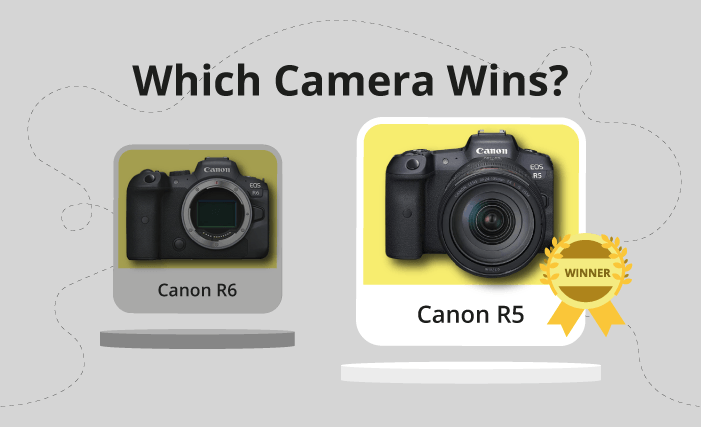Canon EOS R5 vs EOS R6 Comparison
Canon EOS R5
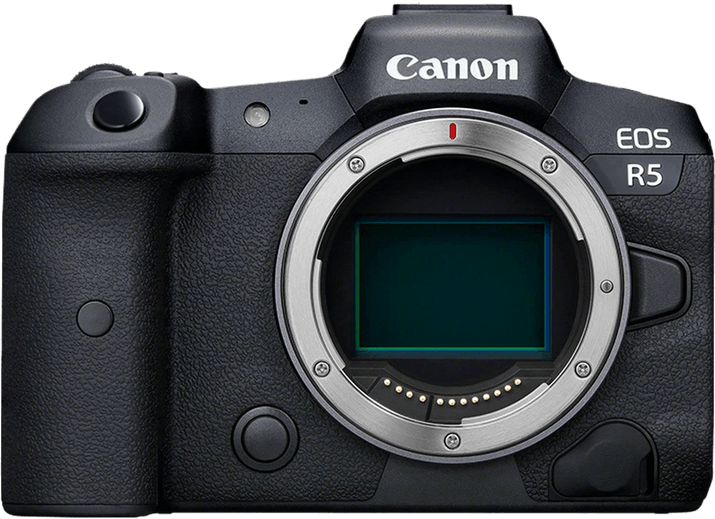
Canon EOS R6
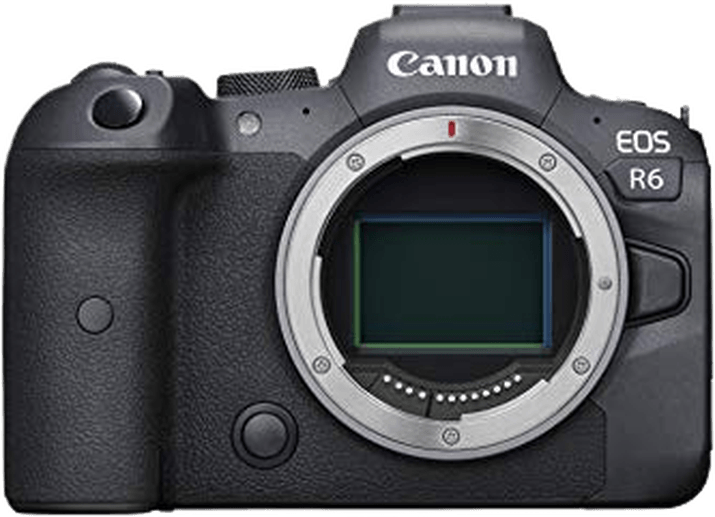
Canon R5 vs R6 Overview
Considering buying the Canon R5 vs R6 and wondering which way to go? You get what you pay for with these two. The Canon EOS R5 is the better camera. But you’ll have to pay over $1,000 more for it!

Canon EOS R5
The main difference between the Canon R5 and R6 is the sensor. The R5 has a 45 MP sensor. The R6’s sensor is only 20 MP, which is very small for a full frame camera these days. That means Canon R5 vs R6 is like a quality bottle of wine vs sparkling grape juice!
Yes, the Canon EOS R6‘s larger pixels improve low-light performance. And the reduced file size increases the number of shots in the buffer.
However, the R5’s extra resolution blows the R6 out of the water. It means you can crop in much more and print at larger sizes. And if you’re a videographer, the benefit is that it allows you to shoot 8K video.
Body and Handling
The Canon EOS R5 and R6 have identical dimensions. They look almost the same front and back (apart from the remote port flap on the R5).
But the top plate of the camera body is different. The R5 has a small LCD screen with a light button. The R6 has a traditional mode dial and a plain dial to the right.
Apart from that, they both have the following:
- An on-off switch
- A flash hot shoe
- Video recording, multi-function (M-Fn), lock and shutter buttons
- A command dial
The Canon EOS R5 is slightly heavier. But it’s not significant. What does matter is the differences between the electronic viewfinders.
Both OLED (organic light emitting diode) viewfinders offer 0.76x magnification with a 120 Hz refresh rate and a 23 mm eyepoint (eye relief). The greater the magnification, the more detail you can see in the viewfinder. The greater the eyepoint, the further away your eye can be. So it’s useful if you wear glasses.
But the Canon EOS R5’s viewfinder has a much higher resolution.
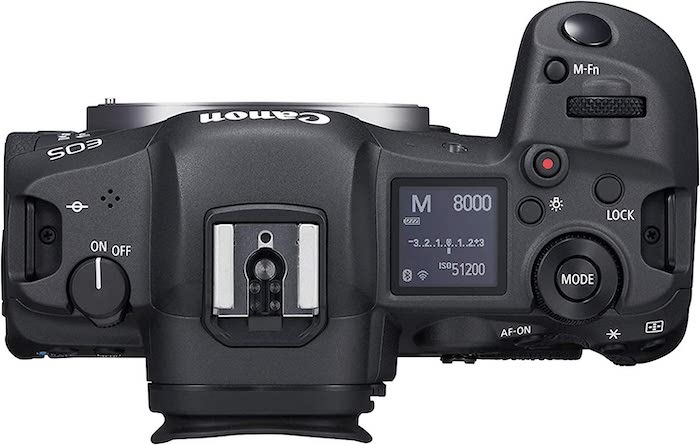
Optics
Resolution vs Low-Light Performance
Normally, there’s a trade-off between image quality and continuous shooting speed. However, these two cameras have the same maximum frame rates even though the R5 has far more megapixels. They both have 12 fps with the mechanical shutter and 20 fps with the electronic shutter.
Instead, the trade-off is between sensor size and low-light performance. The differences aren’t huge. But you “pay” for the following Canon EOS R5 qualities:
- A larger sensor and smaller pixel pitch with a lower maximum ISO
- Worse performance at high ISOs
- Worse minimum focus sensitivity
Both cameras have an Anti-flicker mode.
Autofocus
Both cameras use Dual Pixel CMOS AF II. This is a hybrid phase-detection autofocus system (PDAF) that can focus in only 0.05 seconds.
The excellent light sensitivity also means you can focus with maximum apertures as low as f/22. This is handy when using teleconverters or “slow” lenses.
The autofocus system also boasts “next-generation subject tracking.” It’s based on deep learning artificial intelligence (AI)… Canon engineers have used hundreds of thousands of images to “teach” the camera what to look for.
Both the Canon R5 and R6 can now recognize and follow people, animals, and motorsport vehicles. Subject tracking works on all AF area settings. The refresh rate is at 60 cycles per second (the faster, the better the tracking).
The autofocus works hierarchically. It looks for the eyes of the subject first, then the head, and then the body. In the case of motorsport, it “knows” it should focus on the driver’s helmet.
There is only one real difference between the autofocus systems. The Canon EOS R6 has slightly more focus points if you select an AF position manually (6,072 vs 5,940). However, this is limited to 1,053 (in a 39 x 27 grid pattern) when using Face or Eye detection or Tracking AF.
When shooting video, the number of focus points falls again to 819 (in a 39 x 21 grid)… Both cameras have focus stacking, as well as AE (auto exposure) and focus bracketing.
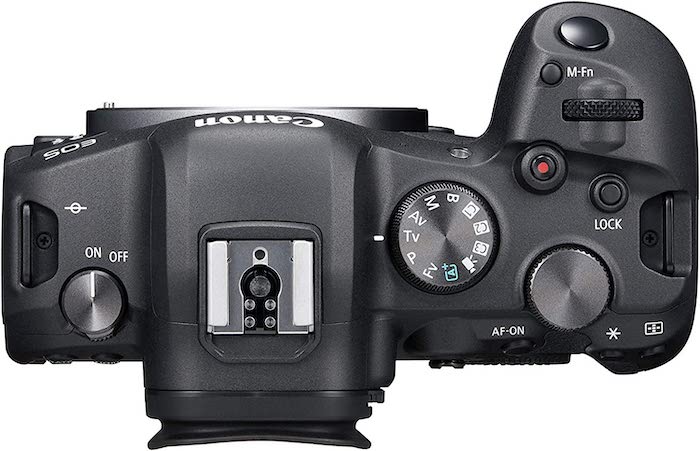
Available Lenses and Stabilization
The cameras have the same Canon RF mount. So they can both be used with Canon’s full range of 32 native lenses—30 of which are full frame. Both cameras also have inbuilt image stabilization that can offer up to 8.0 stops of improvement (depending on the lens).
Canon EOS R5 vs EOS R6 Video Performance
The Canon R5 has a better maximum video resolution and maximum video bit rate.
If you use a CFexpress Type B card, the R5 can shoot in 8K DCI at up to 30p with a resolution of 8192 x 4320 and a maximum bit rate of 2600 mbps. However, the R6 can only manage 4K Ultra HD (no DCI), with the following specs:
- Up to 60p
- With a 1.07x crop
- 3840 x 2160 resolution
- A maximum bit rate of 470 mbps
And the R6 can also shoot 1080p up to 120p.
The internal video modes are the same with both cameras:
- H.264 4:2:0 8-bit
- H.265 4:2:2 10-bit with HDMI output
Both cameras also have time-lapse recordings. But only the R5 features voice tagging!
This is where the Canon EOS R6‘s smaller sensor counts against it. However, I should point out that even the best monitors (like the Apple Studio Display) are only 5K. So any difference between 4K and 8K footage won’t appear.
Canon EOS R5 vs EOS R6 Features and Benefits
Your basic choice is between the better image quality of the Canon EOS R5 and the superior low-light performance of the Canon EOS R6.
The R6 also has more manual focus points, weighs less, gives you more shots per battery charge, and costs a lot less. However, a detailed feature comparison favors the R5 in several areas:
- A larger LCD screen size
- Higher LCD resolution
- Color depth
- Dynamic range
- CFexpress card support
- Better Bluetooth connectivity
- Dual-band Wi-Fi connectivity
Having said that, both cameras conform to the same Canon template, so they share a long list of other features (apart from having a built-in flash):
- A fully articulated LCD screen (for selfies and vlogging)
- Vari-angle LCD touchscreen
- An external flash shoe
- RAW support
- Microphone and headphone ports
- Weather sealing
- Smartphone remote control
- Webcam functionality
Canon EOS R5 vs EOS R6 Storage and Battery
Storage
These two cameras both have dual card slots. The Canon EOS R5 has a CFexpress Type B slot and an SD UHS-II slot. But the R6 has two SD UHS-II slots.
SD cards are cheaper and more popular. But you really need the speed of CFexpress Type B cards to get the most out of the R5’s sensor. So I’m not sure why Canon hasn’t provided two slots for them.
My Sony a1s have two slots that take either SD or CFexpress Type A cards. So I get the best of both worlds!
Batteries
Both cameras take LP-E6NH batteries. They offer a slightly higher capacity than the old LP-E6 batteries (16 Wh vs 14 Wh).
The battery life of the Canon EOS R6 is supposed to be 20 shots better than the R5’s when using the LCD and 40 shots better with the EVF. Just be aware that the LCD rating drops dramatically on both cameras if you increase the live view refresh rate to 120 fps.
However, I’m skeptical of these CIPA ratings. In Africa, I took thousands of images at 30 fps without using a second battery. So I don’t think you need to worry too much that these figures are on the low side.
Canon EOS R5 vs EOS R6 – Our Verdict
The Canon EOS R5 is one of the top three full-frame mirrorless cameras on the market—along with the Sony a1 and the Nikon Z9. It has a large sensor, high frame rate, and an excellent autofocus system.
Plus, it can shoot 8K videos! That makes it an ideal camera for almost any photography style— landscape, wedding, portrait, news, street, sports, or wildlife.
The Canon EOS R6 can’t compete with that. But it depends on what you’re looking for.
If you’re on a budget and don’t want to make large prints or create 8K videos, the R6 is a perfectly good camera. The problem is that our expectations have grown—especially since the mirrorless revolution.
When we look at the Canon R5 vs R6, we see that the Canon EOS R5 is (almost) perfect, while the Canon EOS R6 is just good.

Canon EOS R5
What Camera is Better Than the Canon EOS R5?
The Nikon Z9 is on par with the Canon EOS R5 among high-end mirrorless cameras. But there’s only one camera model with a larger sensor and higher RAW frame rate than both. That’s the Sony a1.
Yes, the R5 might offer a slightly better dynamic range and minimum focus sensitivity at a much lower price. However, the Sony a1 has a 50 MP sensor and can shoot in RAW at 30 fps.
It also offers the following:
- A higher color depth
- Better performance at high ISOs
- A Pixel Shift High-Res mode
- A faster electronic shutter
- A larger viewfinder with better resolution
- Blackout-free shooting
- Unlimited video recording
- Better battery life
If you’re still undecided (or just curious!) check out some other popular camera comparisons:

